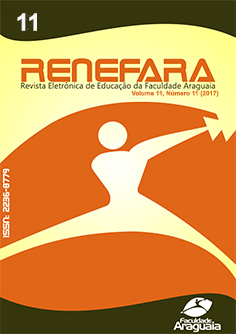THE CELLULAR AS A PEDAGOGICAL RESOURCE FOR ANALYSIS OF PSYCHIC GANGNAM STYLE VIDEO
Keywords:
art, learning, autonomy, experience, reflective.Abstract
This article presents a reflection on the video of Psy artist of the song Gangman Style worked on the discipline of Art. The resource used for analysis of the video was the cell phone and the didactics is based on the analysis of the observations raised pertinent to the scenes presented in the video, the lyrics of the music, as well as the deconstruction of the video through a (re) signification of the use of the Students' cellular devices. To do so, we will rely on several authors to structure our research in three moments, before, during and after. In order to take advantage of each moment in the attempt to reach the maximum of the project that is to add knowledge and explore new possibility according to the reality of the students with the use of technological resources, so that, consequently, we can awaken in students the attention to the Conscious use of this resource. Our study, in addition to dialoguing with the concept of Art, seeks to awaken the students' autonomous and conscious use of the cell phone, in order to arrive at this we start from the debate in the classroom mediated by the teacher. The debate sought to guide students and raise questions to enable each one to reflect and not impose an ideal response and that applied to all involved. The study seeks to dialogue within the diversity of the classroom and that each student can speak and be heard, enabling each one to understand the importance and potential of technological resources.
Downloads
Published
Issue
Section
License
The copyright of the published articles will be transferred to the Uniaaraguaia Magazine, allowing its subsequent reproduction as transcription and with due citation of source. In the event of acceptance and before the publication of the article, the plaintiff (s) shall write a statement formally transferring copyright to the magazine.
The author may also print and distribute copies of his article, provided that he mentions that the rights belong to the Uniaaraguaia Magazine.
Author rights include the right to reproduce in full or partly by any means, distribute this article, including figures and photographs.
By submitting originals to the Uniaaraguaia magazine, the author or authors express agreement with the following terms:
a) Authors maintain copyright and grant Uniaraguaia magazine the right of first publication, with the work simultaneously licensed under the Creative Commons Attribution license that allows the sharing of work with recognition of the authorship and initial publication in this magazine.
b) Authors are authorized to assume additional contracts separately, for non-expiration distribution of the work version published in this magazine (eg publish in institutional repository or as book chapter), with recognition of authorship and initial publication in this journal.
c) Authors are allowed and are encouraged to publish and distribute their work online (eg in institutional repositories or on their personal page) to any point before or during the editorial process, as this can generate productive changes as well as increase the impact and citation of published work.

